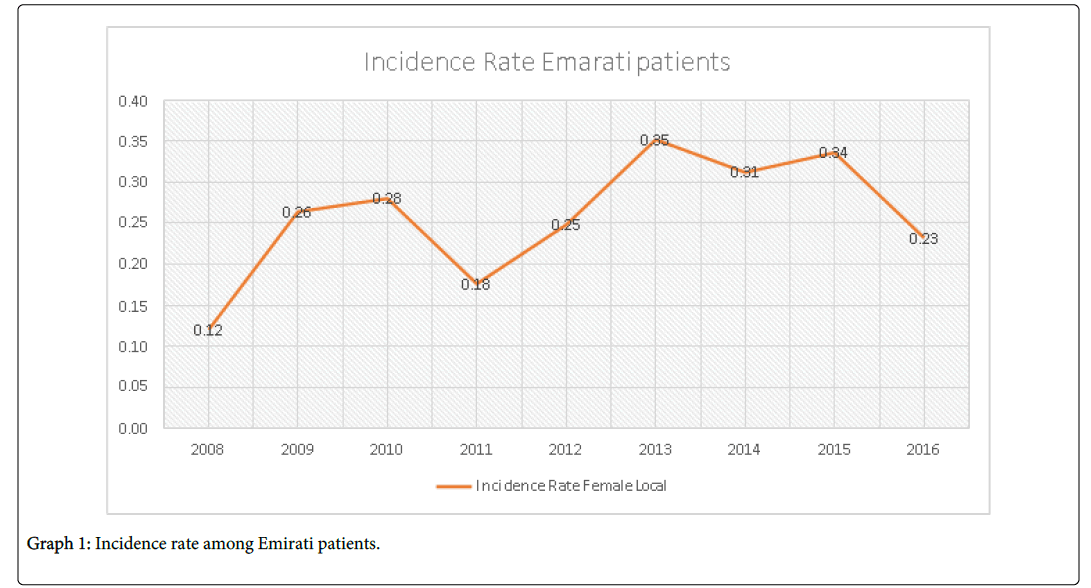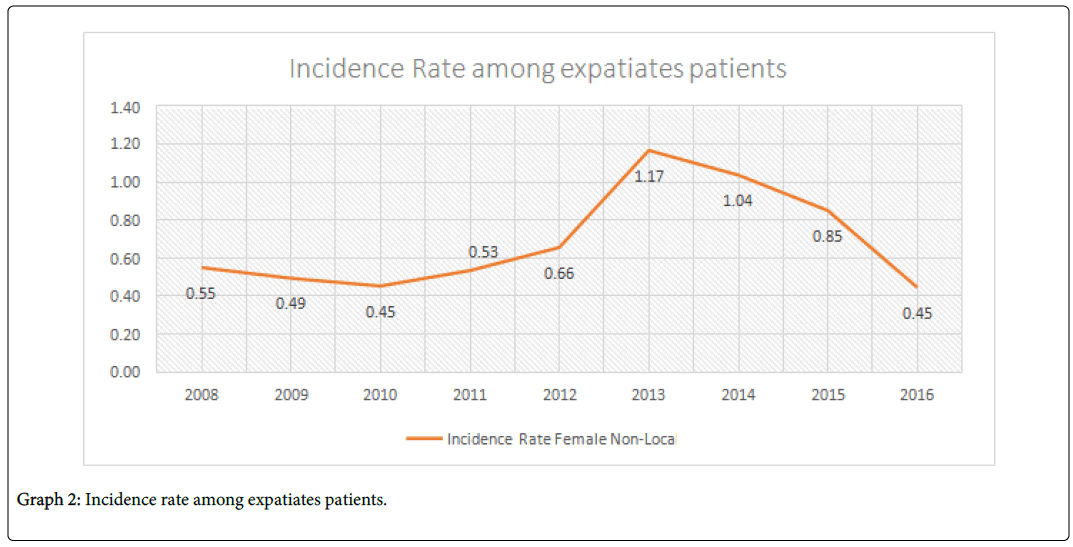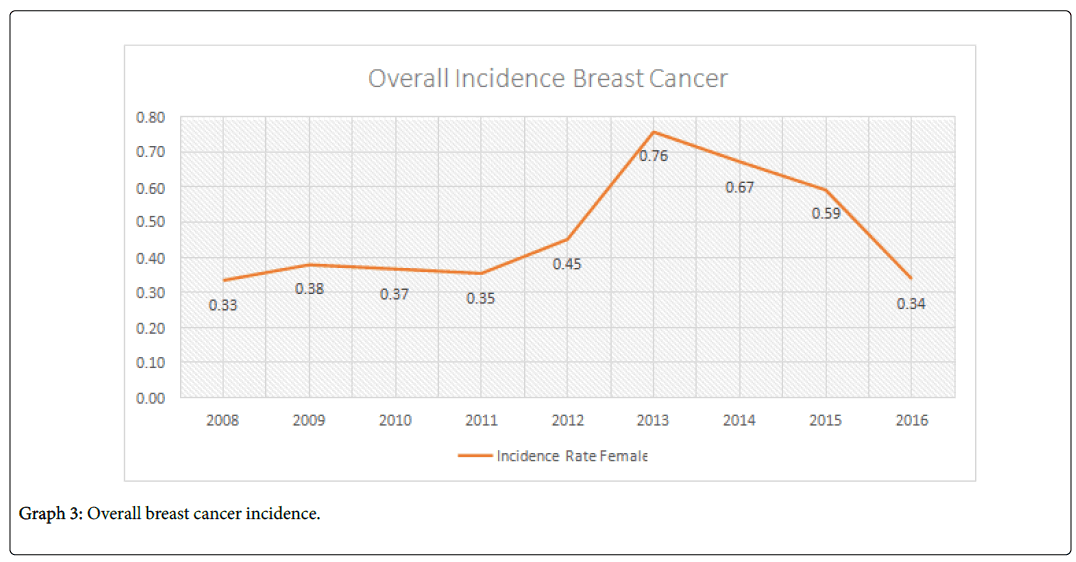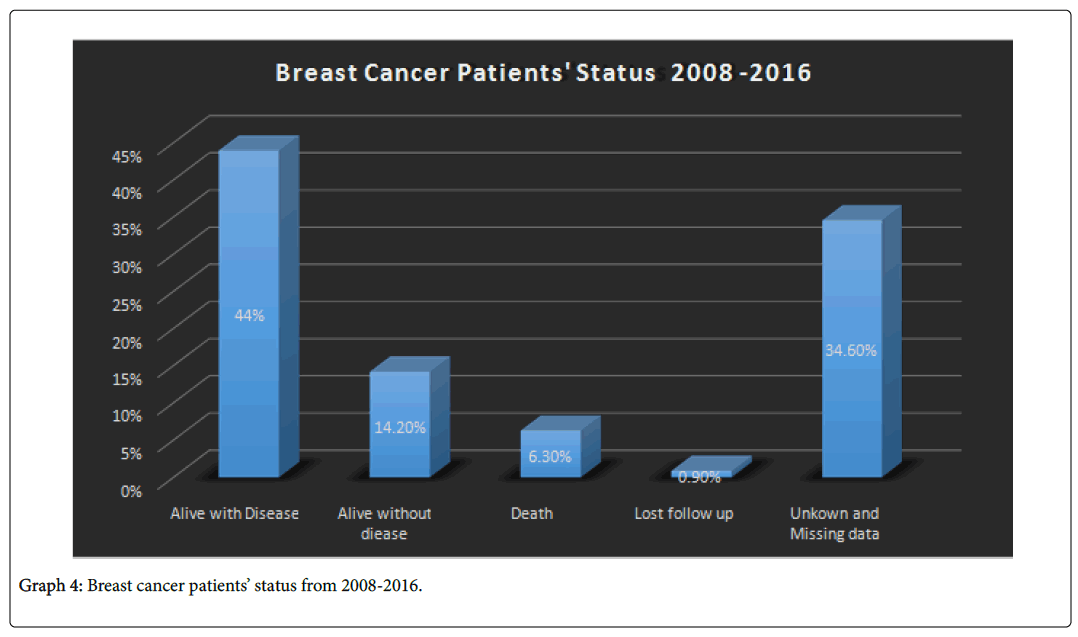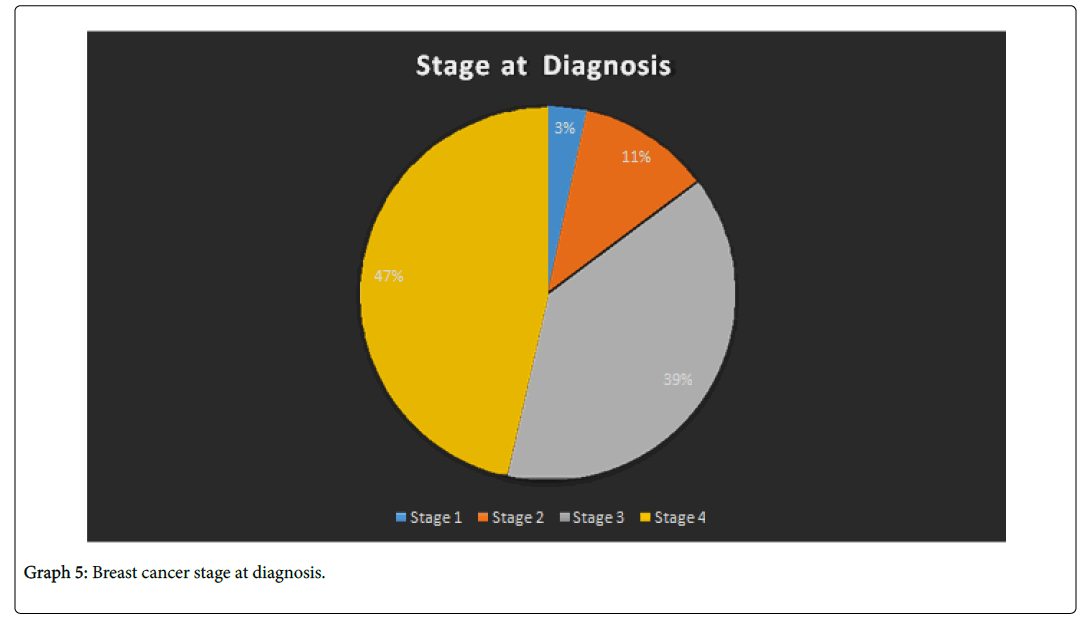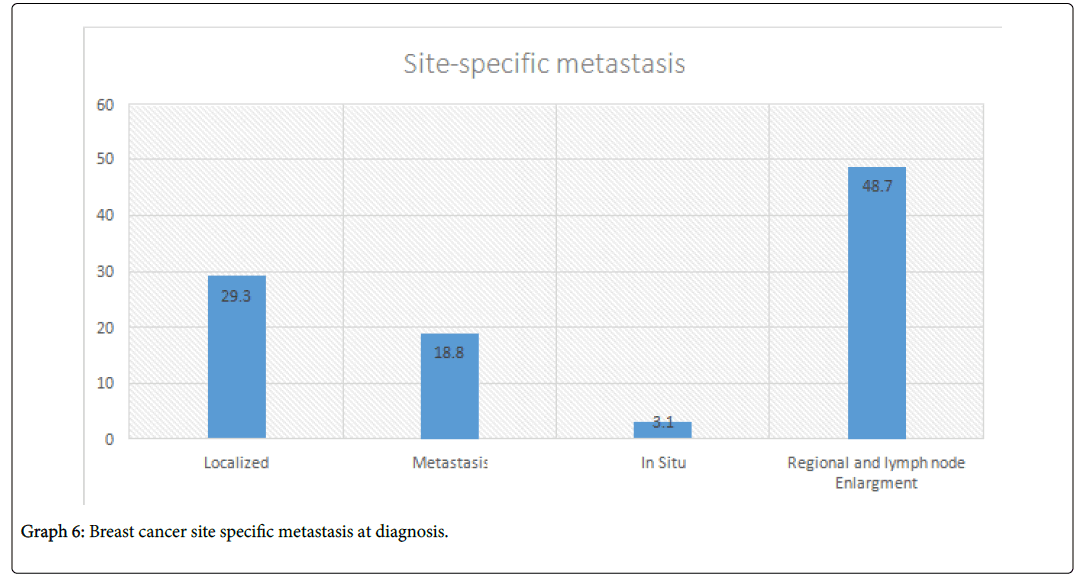An Overview of Breast Cancer Epidemiology, Incidence and Trends from 2008-2016 in Dubai Hospital, Dubai Health Authority, Hospital-Based Cancer Registry 2018
Received: 19-Nov-2018 / Accepted Date: 20-Nov-2018 / Published Date: 27-Nov-2018 DOI: 10.4172/2165-7386.1000346
Keywords: Breast cancer; Incidence; Mortality; Arab country; United Arab Emirates
Introduction
The Arab region, extending from Syria and Lebanon in the north, through to Morocco in the west, Iraq in the east and Yemen in the south, is the residence of over 300 million people.
Cancer, so far, is a considerable issue and the lifestyle alterations underlying the greatly increasing rates for diabetes mellitus imply that the burden of neoplastic disorders will just become more substantial over time, specifically with rising life span and obesity of what are now still young populations [1].
Cancer is a global public health problem inflicting all human age groups and individuals. It is among the most significant world health problems, with approximately 10 million occurrences and 6 million yearly death rates [2]. Boyle et al. stated that, by the year 2030, 70 percent of all newly diagnosed cases will be presented in developing countries [3].
Neoplasm of breast is the most common cancer among women in the Arabic world. The incidence rates of this type of cancer among- Arab females have increased in the past 24 years, plus, nowadays, women get diagnosed with breast cancer at more advanced stages of the cancer [4,5].
Breast cancer is a main cause of disability and mortality among women, predominately young women, in low- and middle-income areas. Despite the fact that overall mortality and incidence rates continue to be lower than that of most privileged areas, case fatality rates from breast cancer remain remarkably high.
These high case fatality rates are probably caused by inadequate awareness of the benefits of treatment and early detection, moreover the lack of appropriate facilities for diagnosis and detection, also deficient accessibility to primary treatment [6].
Physicians in the Arabic world who are dealing with breast cancer have a prevailing impression that breast neoplasms present at a more advanced stage and younger age groups in comparison to western populations. Yet, the data collected from statistics to support this idea are significantly low [7].
Arab populations share common demographical characteristics that encompass broad family size, elevated rates of kind reship and rapid population growth. There is a soaring frequency of autosomal recessive diseases and an increased prevalence of homo zygosity for autosomal dominant traits that have made many diseases more recurrent among Arabs [8].
Mothers with low education level resort to inappropriate treatment institutions. A straight forward relationship was remarked between female’s knowledge and obtaining their healthy attitudes, breast examination for instance. Misinformation among women, unavailability of insurance, low finances, and lack of access to screening programs are major challenges in implementing treatment arrangements and cancer prevention programs in the continent of Asia [9].
However, in some countries in Asia, like South Korea, Hong Kong, Thailand, and Taiwan, impressive programs have been implemented in terms of screening. [10].
Rates of incidence range from 19.3 per 100,000 women in Eastern Africa to 89.9 per 100,000 women in Western Europe, and are high (more than 80 per 100,000) in developed regions of the world (except Japan) and low (less than 40 per 100 000) in most of the developing region [11].
Hospital Cancer Registries have an essential part in cancer control schemes to arrange top priority cancers, trends, prevalence and to be part of the world-wide cancer research strategies. Population-based cancer registration offers the paramount standard for cancer mortality and cancer incidence, to the analysis of potential risk factors for cancer and to validate the effectiveness of cancer control efforts.
The registry also has an integral role in implementing studies related to public health to assess public health risks as a measuring tool for epidemiological studies through surveillance, and as a decisionmaking support for national and local public health administrations. [12].
Data that involve incidence (the figure of newly diagnosed cases per annum) are acquired from population-based cancer registries, which may cover the whole national populations. Nevertheless more often, they cover smaller and subnational areas especially in developing countries in urban environments, such as main cities [13]. The aim of this paper is to study the epidemiology, trends, and incidence of breast cancer in Dubai hospital.
Methodology
Dubai hospital Cancer Registry is a hospital -based registry founded in 2006, to record the annual incidences of all cancers, overall and by gender and to observe cancer incidence, trends and changes. The cancer registry covers the cancer patients in Emirate Dubai, including all Emirati and all the expatiates population groups and it is estimated to be 3.137 million.
Cancer cases are identifiable the registry through active data collection methods, where the patients whom treated in Dubai Hospital registry Authority only registered in Dubai hospital cancer registry. Data are entered into a secured database according to coding standards of the International Classification of Disease for Oncology. Ethical approval was obtained from the research committee in Rashid hospital in order to access the data in cancer registry.
The data were coded no names, medical record number, an (SPSS) contact details were shown in the current study. Statistical Package for the Social Science version 20 and Microsoft Excel were used to analyze the data.
Results
The available data in the cancer registry are from 2006, but due to the missing and the incomplete information, the data that were used in the current study cover the period from 2008 to 2016.
A total number of 1317 patients were diagnosed with breast cancer from 2008 to 2016. On the other hand, the total number of registered patients was obtained from the medical record department to calculate the incidence.
Therefore, the numerator is the number of breast cancer patients for each year and the denominator is the number of registered patients for each year. The incidence was calculated per 1000.
For more clarification, the incidence was found as the following:
• The incidence and trend among Emirati patients
• The incidence and trend among expatiates patients
• The overall incidence among Emirati and expatiates patients
• The overall incidence among all Breast cancer patients.
The incidence among Emirati patients in 2008 was 0.12 per 1000 and it doubled in 2009 to be 0.26 per 1000. While in 2011, the incidence decreased to 0.18 per 1000. Again, in 2013 the incidence reached a peak with 0.35 per 1000. During the period 2013-2016, the incidence gradually decreased to be 0.23 per 1000 in 2016 as shown in Graph 1.
Taking in the consideration that the United Arab Emirates is a multi-nationality country and there are more than 200 nationalities, the number of cases was much higher compared to the Emirati patients. In 2008 the incidence was 0.55 per 1000 and it decreased to 0.45 per in 2010. The number of cases was gradually increasing to be 1.17 per 1000 in 2013. There was sharp drop in the incidence between 2013-2016 to reach 0.45 per 1000 in 2016 as shown in Graph 2.
In the same token, the incidence was calculated to all breast cancer patient out of all the registered patients to Dubai hospital. In 2008 the incidence was 0.33 per 1000 and gradually increased to reach the peak 0.76 per 1000 in 2013. Similarly to the last results, the incidence decreased year over year to be 0.34 per in 2016 as shown in Graph 3.
On the other hand the data were analyzed based on the patient’s status. The result reflected that around 44% were alive with disease, 14.2% alive without disease, 6.30% death, and approximately 34.6% unknown and missing data, while the minority 0.90% lost follow up as shown in Graph 4.
In the same token the data analyzed based on the stage at the diagnosis. The results revealed that the vast majority (47%) were stage 4 at the diagnosis, and 11% were stage 2, and 39% were stage 3, and 3% were stage 1 at diagnosis as shown in Graph 5.
From another aspect, the data revealed that 48.7% of the patients had regional and lymph node enlargement, 3.1% in-situ, 18.8% metastasis, and 29.3% had localized cancer as shown in Graph 6.
Discussion
Cancer is one of the most significant health issues world-wide. In developed countries, 55% of the load of diseases is related to cancer. Breast neoplasm is without doubt, the most occurring cancer among women. Over 1.3 million individuals suffer from this type of cancer are diagnosed ever year around the world [14]. It was calculated more than 508,000 women around the world have died because of breast cancer in 2011. The incidence of breast cancer ranges from 89.7 per 100,000 women in the region of East Africa to 19.4 per 100,000 women in West Europe [15]. Breast cancer is the most frequent malignancy among Asian women [14].
As noticed from the results, the breast cancer incidence varied from year to another among Emirati patients. The peak incidence was in 2013. The same result was seen among expatiates patient. In a research done by Ghoncheh in 2015, it revealed that the incidence of breast Cancer in Asia varied from one country to another. Whereas in United Arab Emirates, 568 patients were diagnosed (22.8 per 100,000), while in Saudi Arabia there were 2791 patients (21.7 per 100.000). Meanwhile in Oman, the number breast cancer cases was 195 patients (16.4 per 100.000). In Kuwait, 316 patients were diagnosed with breast cancer in the year 2015 (26.9 per 100.000). While Jordan had 1237 patients diagnosed with cancer (39.4 per 100.000).
The increasing incidence of breast cancer is clearly observed in the last decade in Dubai hospital. It is likely the result of changes in reproductive factors (including the increased use of postmenopausal hormone therapy) as well as an increased screening intensity [16].
Breast cancer is the most reported type of cancer affecting females of the Northern African women population. Its ASI rate varies from 9.5 to 54 per 100.000 women. Moreover, in North Africa, the data from the regional registries of Tunisia, Algeria and Morocco demonstrate that breast neoplasm is the most reported type of cancer among women making it account for ¼ of whole reported cancers [17].
Among 1317 breast cancer patients, 6.30% lost their lives over the last decade in Dubai hospital. Compared to Europe which accounts for 23.4% of the global cancer cases, it came with 20.3% of the cancer related mortality, although it has only 9.0% of the global population. Both Americas account for 13.3% of the world population and they represent 21.0% of the incidence and 14.4% of death around the globe. In comparison to other regions of the world, the proportions of cancer related mortality in Africa and in Asia (7.3%, and 57.3%, respectively) are greater than that of the proportions of incident cases (5.8% and 48.4% respectively). It is because these regions have more frequent incidence of some neoplasm types attributed to greater mortality rates and more dissatisfactory prognosis, plus to the inadequate access to treatment and on-time diagnosis in various countries [18].
Surprisingly, the vast majority of patients who were diagnosed with breast cancer in Dubai hospital were at stage 4 of the disease. In contrast with Northern American and Europe, the tumor size and the stage at time of diagnosis of breast cancers in the Morocco are greatly more advanced. In addition, the pathological profile of breast neoplasms appears to be associated with patients’ age. [19].
In terms of the site specific metastasis at the time of diagnosis, 48.7 % of patients had lymph node enlargement and regional involvement, in detail: 29.3% had localized cancer, 18.8% metastasis and 3.1 % in situ . Therefore it can concluded that there is an absent health awareness regarding medical follow up and early detection. No more than 3.1% had cancer in-situ , such patients most probably had an adequate accessibility to health care facilities and early detection. It can be noticed in the Chalabi et al. study based on data acquired from 2002 to 2007 that Moroccan, Tunisian and Lebanese patients were 10 years younger than patients in the Western world and became more affected with tumors of luminal B (“Luminal B neoplasms; in general, grow slightly quicker than luminal a neoplasms and their prognosis is merely worse”) type with greater aggressive features: more elevated SBR grade and a higher significant nodal invasion rate [20].
Limitations
The limitation of this study should be addressed. The study of the epidemiology and the incidence were studied in Dubai hospital only and cannot be generalized to all the United Arab Emirates population or other worldwide studies. In addition, there is no central cancer registry neither in Dubai nor in the United Arab Emirates.
Conclusion
The incidence of breast cancer in Dubai hospital was various from one year to another. But as noticed from the result that the majority were diagnosed very late and at advance stages, in addition with lymph node involvement. On the other hand, the data revealed that one third of the patient lost follow up and missing data. The improvement of cancer registry is required to have more accurate statistics.
Around the half of patient’s diagnosed with regional and lymph node enlargement could be due to lack of awareness. Educational actions must take into consideration the fact that lots of women, specifically those with lower educational level and financial income, could not pursue care when they experience a breast lump, for the reason that they are not aware of what it means.
They highly take into consideration the stigma of cancer and being denounced by their communities and families, fear of the possibility of losing their breasts, or they suppose that there are no appropriate treatments for the cancer particularly if they have known that all women with breast cancer died. Early find of breast neoplasms without question can make a paramount part in decreasing its burden and incidence. Mortality rates due to breast neoplasms can be lowered if they were early detected and received early treatments. Casual breast examinations and mammograms, nevertheless, do not prevent cancer, yet these screening procedures provide a significant early detection; when treatment can most probably to be fruitful.
Despite the fact that the absence or presence of risk factors do not provide confirmation for establishing a diagnosis of a cancer even not for an individual, modifying a number of the risk factors is an essential key in the prevention of breast neoplasms and other types of cancer. Health awareness campaign about breast cancer plus increasing the knowledge for women regarding self-examination are absolutely necessary measures.
Conflict of Interests
All authors declared that these are no conflict of interest.
References
- Salim EI, Moore MA, Al-Lawati JA, Al-Sayyad J, Bazawir A, et al. (2009) Cancer epidemiology and control in the arab world-past, present and future. Asian Pac J Cancer Prev 10: 3-16.
- Parkin DM (2001) Global Cancer statistics in the year 2000. Lancet Oncol 2: 533–543.
- Boyle N, Levine D (2008) Objective and subjective breast cancer risks. Cancer Nurs 35: 523-525.
- Azaiza F, Cohen M, Awad M, Daoud F (2010) Factors associated with low screening for breast cancer in the Palestinian authority: Relations of availability, environmental barriers, and cancer-related fatalism. Cancer 116: 4646-4655.
- Tarabeia J, Baron-Epel O, Barchana M (2007) A comparison of trends in incidence and mortality rates of breast cancer, incidence to mortality ration and stage at diagnosis between Arab and Jewish women in Israel, 1979- 2002. Eur J Cancer Prev 16: 36-42.
- Porter P (2008) “Westernizing†women’s risks? Breast cancer in lower-income countries. New Eng J of Med 358: 213-216.
- Najjar H, Easson A (2010) Age at diagnosis of breast cancer in Arab nations. Int J Surg 8: 448-452.
- Teebi A, Teebi S (2005) Genetic diversity among the Arabs. Community Genet 8: 21-26.
- Agarwal G, Pradeep P, Aggarwal V, Yip CH, Cheung PS (2007) Spectrum of breast cancer in Asian women. World J Sur 31: 1031-1040.
- Sankaranarayanan R, Ramadas K, Qiao Y (2014) Managing the changing burden of cancer in Asia. BMC Med 12: 3.
- Ferlay J, Shin HR, Bray F, Forman D, Mathers C, et al. (2010) GLOBOCAN 2008: Cancer Incidence and Mortality Worldwide IARC Cancer Base No. 10, Lyon, France: International Agency for Research on Cancer.
- Joachim C, Godaert L, Dramé M, Véronique-Baudin J, Macni J, et al. (2017) Overall survival in elderly patients with colorectal cancer: A population-based study in the caribbean. Cancer Epidemiology 48: 85.
- Jemal A, Bray F, Melissa M, Ferlay J, Ward E, et al. Global Cancer Statistics. CA: Cancer J Clin 61: 69-90.
- Althuis M, Dozier J, Anderson W, Devesa S, Brinton L (2005) Global trends inbreast cancer incidence and mortality 1973-1997. Int J Epidemiol 34: 405-412.
- Ferlay J, Bray F, Pisani P, Parkin D (2004) GLOBOCAN 2002: Cance incidence, mortality and prevalence worldwide, Lyon: IARC Press.
- World Health Organization, IARC (International Agency of Research in Cancer) Â (2018) Latest global cancer data: Cancer burden rises to 18.1 million new cases and 9.6 million cancer deaths in 2018.
- Belkacemi Y, Pelagia G, Tsoutsou, Boussen H, Geara F, et al. (2017) Epidemiology of Breast Cancer in Young Women in the Southern part of the Mediterranean Area. J Can Epi Treat 1: 1-7.
- Belkacemi Y, Tsoutsou PG, Boussen H, Geara F, Bounedjar A, et al. (2017) Epidemiology of Breast Cancer in Young Women in the Southern part of the Mediterranean Area. J Can Epi Treat 1: 1-7.
Citation: Salim NA, Hussain H,Tuffaha Md, Kathamuthu R, Tamimi A, et al. (2018) An Overview of Breast Cancer Epidemiology, Incidence and Trends from 2008-2016 in Dubai Hospital, Dubai Health Authority, Hospital-Based Cancer Registry 2018. J Palliat Care Med 8: 346. DOI: 10.4172/2165-7386.1000346
Copyright: © 2018 Salim NA, et al. This is an open-access article distributed under the terms of the Creative Commons Attribution License, which permits unrestricted use, distribution, and reproduction in any medium, provided the original author and source are credited.
Select your language of interest to view the total content in your interested language
Share This Article
Recommended Journals
Open Access Journals
Article Tools
Article Usage
- Total views: 6585
- [From(publication date): 0-2018 - Oct 16, 2025]
- Breakdown by view type
- HTML page views: 5602
- PDF downloads: 983

